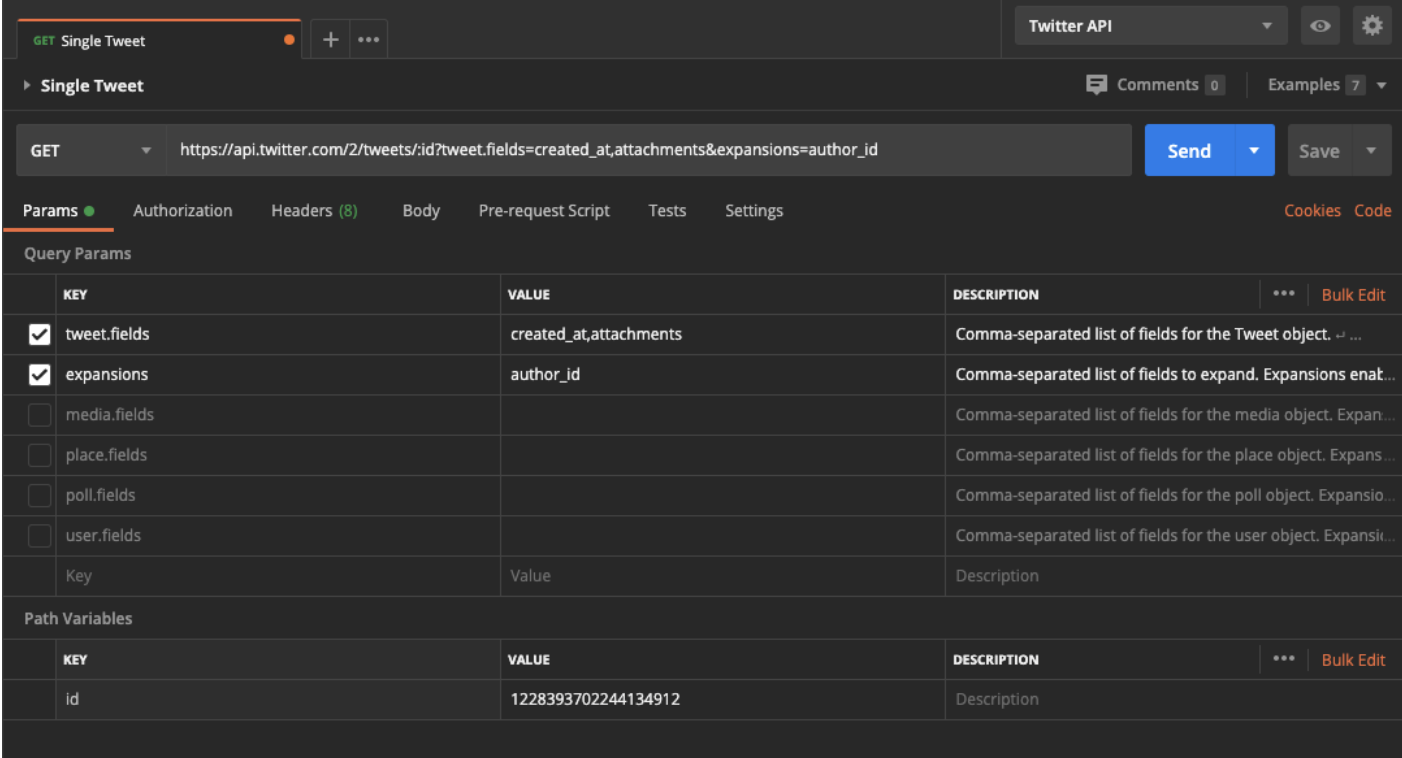Introduction
Postman is a desktop and web application that allows you to make requests to an API from a graphical user interface. We recommend using Postman with the X API, X Ads API, and Labs endpoints when exploring the APIs functionality, as well as when you are troubleshooting issues with your application. We currently have two Postman collections available:Prerequisites
Before you get started with using Xs Postman collections, you will need to make sure you have the proper access and credentials for the X developer platform tool of your choosing. You can learn more about getting access via our “Getting started” page. Once you have a developer account, have set up a developer App and have a set of authentication keys and tokens, and have properly set up your environment to make requests to the specific API that you plan to use, you can follow the below steps to get started.Getting started with X’s Postman collections
Step one: Add one of the X Postman collections to your account
While you could build out the specific endpoints that you’d like to use within Postman, we did all of the heavy lifting for you and built out a ready to use collection of relevant APIs. Just click one of the links in the earlier “Postman collections” section and a collection with all of the endpoints associated with the selected API will be added to your Postman app. These collections are also available in the Postman API network. Each endpoint will automatically include available parameters, example responses, and authentication type plugged in, so you just need to add your credentials and parameter values to start exploring the functionality. In this example, we are going to work with the X API v2 collection.Step two: Add your keys and tokens as environmental variables
When you add the collection to your Postman instance, it will automatically add an environment called ‘X API v2’, which you will need to add your keys and tokens to. In this step, we will walk you through the process of adding your keys and tokens from your developer App into the ‘X API v2’ environment. To add your keys and tokens to the “X API v2” environment, click on the “manage environments” button in the top right corner of Postman., you will need to click on the settings button in the top right corner.
| VARIABLE | INITIAL VALUE | CURRENT VALUE |
|---|---|---|
| consumer_key | QAktM6W6DF6F7XXXXXX | QAktM6W6DF6F7XXXXXX |
| consumer_secret | AJX560A2Omgwyjr6Mml2esedujnZLHXXXXXX | AJX560A2Omgwyjr6Mml2esedujnZLHXXXXXX |
| access_token | 1995XXXXX-0NGqVhk3s96IX6SgT3H2bbjOPjcyQXXXXXXX | 1995XXXXX-0NGqVhk3s96IX6SgT3H2bbjOPjcyQXXXXXXX |
| token_secret | rHVuh7dgDuJCOGeoe4tndtjKwWiDjBZHLaZXXXXXX | rHVuh7dgDuJCOGeoe4tndtjKwWiDjBZHLaZXXXXXX |
| bearer_token | AAAAAAAAAAAAAAAAAAAAAL9v6AAAAAAA99t03huuqRYg0mpYAAFRbPR3XXXXXXX | AAAAAAAAAAAAAAAAAAAAAL9v6AAAAAAA99t03huuqRYg0mpYAAFRbPR3XXXXXXX |
Step three: Select an endpoint
Next step is to choose an endpoint from the collection and start to build your request. You can select an endpoint from the right-hand side navigation. Here is what this looks like:
Step four: Add values to the Params tab
Next step will have you navigate to the Params tab. You should see a set of inactive params with descriptions that explain what the parameter does, and a list of all of the potential values that you can pass with your request. In this example, we are going to activate the expansions and tweet.fields query parameters and add the following values:| Key | Value |
tweet.fields | created_at,attachments |
| expansions | author_id |
1228393702244134912:
https://x.com/XDevelopers/status/1228393702244134912
On the Params tab, scroll down past all of the query parameters to display the “Path Variables” section. We will be adding the Post ID that you would like to use as a value to the id key.
If you’ve entered everything from this step correctly, the Params tab should look like the following:

Step five: Send your request and review your response
Now that everything is set up in your request, you can click the “Send” button. If everything was set up properly, you should receive the following payload:Generating a User Access Token with Postman:
Using OAuth 1.0a to generate a user access token
Review the three step process used in the OAuth1.0a flow test collection.Using OAuth 2.0 to generate a user access token
If you want to generate an OAuth 2.0 user access token in Postman you can generate OAuth 2.0 access tokens to use in conjunction with the X API v2 Postman collection. If you click on the collection in your workspace and go to the tab entitled “Auth” and select the type to be “OAuth 2.0”. From there under the heading “Configure New Token” go to where it says “Configuration Options”. You can update the “Grant Type” to “Authorization Code (With PKCE)”. You will want to update your Callback URL to match the callback url associated with your application. Additionally, you will want to update the following parameters:- Auth URL - https://x.com/i/oauth2/authorize
- Access Token URL - https://api.x.com/2/oauth2/token
- Client ID - Your OAuth2.0 client ID from Dev Portal
- Client Secret - If you are using a confidential client
- Update Scope - Scopes to match the endpoints you want to connect to. Example “tweet.read users.read”
- Your callback URL (also known as the redirect URL). This must match what you have in your App’s authentication settings.
- State - state